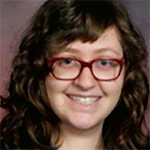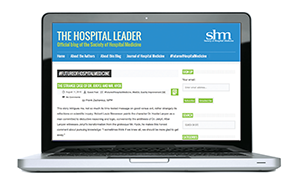User login
The following are excerpts of those posts.
Why We Should Care about Alarm Fatigue

When I arrived back at the Children’s Hospital of Philadelphia (CHOP) after my first year of medical school, I knew what was awaiting me: thousands of alarms from physiologic monitors, most of them inconsequential, lined up neatly in spreadsheets, splattered all over research databases, lighting up on video screens, chirping down hallways and up elevators. Of course, they were incessantly firing at the bedside, but when patient care is video recorded for Dr. Bonafide’s research study on alarm fatigue, those patient care hours turn into data points that live on hard drives and servers waiting to be classified, annotated, and cataloged by a team of research assistants, including me.
I began working at the CHOP while attending the University of Pennsylvania’s post-baccalaureate premed program. What started as a temporary summer research position turned into an almost three-year endeavor. The pilot that I helped design uses video cameras in hospitalized patient rooms to record patient care. We download the video, edit it so we can review multiple viewing angles at one time, download a spreadsheet of all of the alarms that fired during the study period, and then, with a little patience and some subtraction, we can line up every alarm that fired with the video clip. That’s the easy part.
This small pilot has transformed into a much larger study with a much larger volume of alarms. Since I started medical school last July, the research team has steadily collected video data all year. With support from SHM’s student scholar grant program, I have been able to return to CHOP for the summer. And now the video review begins.
The First Two Years—Pathways and Patient Outcomes

The first two years of our medical curriculum are an introduction to the human body’s normal and pathophysiology and an attempt to untangle the complex pathways involved in the interactions between self and nonself. We hope to make connections between our physical exam findings and the physiologic pathways we have at our educational foundation. We begin to realize that there is a fine line to walk when treating a patient: Altering the inputs of a single system can drastically affect the outputs of another.
If we place patient outcomes in the context of the dance that occurs in clinical care for patients on the wards, similar to the downstream effects of disrupting biological pathways in illness, there is a multifactorial system underlying hospitalized patient outcomes.
Prior to medical school, I worked for several years as a population health epidemiologist in the Democratic Republic of Congo and then as a research data analyst at the University of Chicago. During my work in both of these settings, I quickly learned the relevance of contextual clues in complex systems-based problem solving. Over the course of my first year of medical school, I realized that nowhere is this creative use of information more important than in the inpatient setting, where we attempt to distill out the most important available information when assessing a patient.
But there are caveats to our interpretations of data points: Are we recognizing the most relevant physiologic associations when making clinical decisions? Are patient data really telling us what we think they are? What systemic factors are at play when patients experience an adverse outcome?
In my exploration of the importance of contextualizing inpatient data, I have been incredibly fortunate to work with Dana Edelson, MD, MS, and Matthew Churpek, MD, PhD, MPH, two mentors at the University of Chicago who are equally passionate about asking these same questions surrounding clinical care. Using ward patient data, we have investigated the importance of physician judgment in clinical deterioration and documented the need for greater sensitivity in recognition of sepsis and organ dysfunction in ward patients. But what can be done to reorient clinicians who are overwhelmed by and desensitized to data streams and bedside alarms?
Improving Patient Care as a Trainee

Patient safety has always been a priority for me, but it is only recently that I became aware of the many issues that threaten quality of care for patients. As a medical student, I vividly remember shadowing at the hospital and being shocked at what I saw. I walked through patient rooms and noticed loud beeps, the constant chatter of hospital staff, and the automatic entrance into patients’ rooms without even a knock. I wondered whether all of the disruptions and commotion impacted patient recovery in the hospital and after discharge. After pondering this, I decided that I wanted to take action and see what I, as a medical student, could do to improve daily inpatient conditions.
In order to begin addressing my vision, I knew I needed to find the right mentor in the right location. As a medical student, I feel like my life is on pause at times. During the school year, when exams come in constant waves and my days are spent with my head in notes and books, I am pausing my time with friends and family, using my energy to pursue my dream of helping others improve their health. While I am blessed to have such an opportunity, I knew that during my time off between my first and second year of medical school, I wanted to be in Chicago, near my close friends. And, from there, it seemed as if everything fell into place perfectly. I found on the University of Chicago Medical School website that Dr. Vineet Arora is a prominent Society of Hospital Medicine member who was looking for medical students to conduct research on sleep/functional recovery during hospital stay and post-discharge. The minute I spoke to Dr. Arora, I knew that she would be a great mentor. Not only are her credentials and accomplishments unbelievable, but I could tell she is really passionate about the work she is doing. Her excitement for the project is contagious, and I started getting really excited to start!
The following are excerpts of those posts.
Why We Should Care about Alarm Fatigue

When I arrived back at the Children’s Hospital of Philadelphia (CHOP) after my first year of medical school, I knew what was awaiting me: thousands of alarms from physiologic monitors, most of them inconsequential, lined up neatly in spreadsheets, splattered all over research databases, lighting up on video screens, chirping down hallways and up elevators. Of course, they were incessantly firing at the bedside, but when patient care is video recorded for Dr. Bonafide’s research study on alarm fatigue, those patient care hours turn into data points that live on hard drives and servers waiting to be classified, annotated, and cataloged by a team of research assistants, including me.
I began working at the CHOP while attending the University of Pennsylvania’s post-baccalaureate premed program. What started as a temporary summer research position turned into an almost three-year endeavor. The pilot that I helped design uses video cameras in hospitalized patient rooms to record patient care. We download the video, edit it so we can review multiple viewing angles at one time, download a spreadsheet of all of the alarms that fired during the study period, and then, with a little patience and some subtraction, we can line up every alarm that fired with the video clip. That’s the easy part.
This small pilot has transformed into a much larger study with a much larger volume of alarms. Since I started medical school last July, the research team has steadily collected video data all year. With support from SHM’s student scholar grant program, I have been able to return to CHOP for the summer. And now the video review begins.
The First Two Years—Pathways and Patient Outcomes

The first two years of our medical curriculum are an introduction to the human body’s normal and pathophysiology and an attempt to untangle the complex pathways involved in the interactions between self and nonself. We hope to make connections between our physical exam findings and the physiologic pathways we have at our educational foundation. We begin to realize that there is a fine line to walk when treating a patient: Altering the inputs of a single system can drastically affect the outputs of another.
If we place patient outcomes in the context of the dance that occurs in clinical care for patients on the wards, similar to the downstream effects of disrupting biological pathways in illness, there is a multifactorial system underlying hospitalized patient outcomes.
Prior to medical school, I worked for several years as a population health epidemiologist in the Democratic Republic of Congo and then as a research data analyst at the University of Chicago. During my work in both of these settings, I quickly learned the relevance of contextual clues in complex systems-based problem solving. Over the course of my first year of medical school, I realized that nowhere is this creative use of information more important than in the inpatient setting, where we attempt to distill out the most important available information when assessing a patient.
But there are caveats to our interpretations of data points: Are we recognizing the most relevant physiologic associations when making clinical decisions? Are patient data really telling us what we think they are? What systemic factors are at play when patients experience an adverse outcome?
In my exploration of the importance of contextualizing inpatient data, I have been incredibly fortunate to work with Dana Edelson, MD, MS, and Matthew Churpek, MD, PhD, MPH, two mentors at the University of Chicago who are equally passionate about asking these same questions surrounding clinical care. Using ward patient data, we have investigated the importance of physician judgment in clinical deterioration and documented the need for greater sensitivity in recognition of sepsis and organ dysfunction in ward patients. But what can be done to reorient clinicians who are overwhelmed by and desensitized to data streams and bedside alarms?
Improving Patient Care as a Trainee

Patient safety has always been a priority for me, but it is only recently that I became aware of the many issues that threaten quality of care for patients. As a medical student, I vividly remember shadowing at the hospital and being shocked at what I saw. I walked through patient rooms and noticed loud beeps, the constant chatter of hospital staff, and the automatic entrance into patients’ rooms without even a knock. I wondered whether all of the disruptions and commotion impacted patient recovery in the hospital and after discharge. After pondering this, I decided that I wanted to take action and see what I, as a medical student, could do to improve daily inpatient conditions.
In order to begin addressing my vision, I knew I needed to find the right mentor in the right location. As a medical student, I feel like my life is on pause at times. During the school year, when exams come in constant waves and my days are spent with my head in notes and books, I am pausing my time with friends and family, using my energy to pursue my dream of helping others improve their health. While I am blessed to have such an opportunity, I knew that during my time off between my first and second year of medical school, I wanted to be in Chicago, near my close friends. And, from there, it seemed as if everything fell into place perfectly. I found on the University of Chicago Medical School website that Dr. Vineet Arora is a prominent Society of Hospital Medicine member who was looking for medical students to conduct research on sleep/functional recovery during hospital stay and post-discharge. The minute I spoke to Dr. Arora, I knew that she would be a great mentor. Not only are her credentials and accomplishments unbelievable, but I could tell she is really passionate about the work she is doing. Her excitement for the project is contagious, and I started getting really excited to start!
The following are excerpts of those posts.
Why We Should Care about Alarm Fatigue

When I arrived back at the Children’s Hospital of Philadelphia (CHOP) after my first year of medical school, I knew what was awaiting me: thousands of alarms from physiologic monitors, most of them inconsequential, lined up neatly in spreadsheets, splattered all over research databases, lighting up on video screens, chirping down hallways and up elevators. Of course, they were incessantly firing at the bedside, but when patient care is video recorded for Dr. Bonafide’s research study on alarm fatigue, those patient care hours turn into data points that live on hard drives and servers waiting to be classified, annotated, and cataloged by a team of research assistants, including me.
I began working at the CHOP while attending the University of Pennsylvania’s post-baccalaureate premed program. What started as a temporary summer research position turned into an almost three-year endeavor. The pilot that I helped design uses video cameras in hospitalized patient rooms to record patient care. We download the video, edit it so we can review multiple viewing angles at one time, download a spreadsheet of all of the alarms that fired during the study period, and then, with a little patience and some subtraction, we can line up every alarm that fired with the video clip. That’s the easy part.
This small pilot has transformed into a much larger study with a much larger volume of alarms. Since I started medical school last July, the research team has steadily collected video data all year. With support from SHM’s student scholar grant program, I have been able to return to CHOP for the summer. And now the video review begins.
The First Two Years—Pathways and Patient Outcomes

The first two years of our medical curriculum are an introduction to the human body’s normal and pathophysiology and an attempt to untangle the complex pathways involved in the interactions between self and nonself. We hope to make connections between our physical exam findings and the physiologic pathways we have at our educational foundation. We begin to realize that there is a fine line to walk when treating a patient: Altering the inputs of a single system can drastically affect the outputs of another.
If we place patient outcomes in the context of the dance that occurs in clinical care for patients on the wards, similar to the downstream effects of disrupting biological pathways in illness, there is a multifactorial system underlying hospitalized patient outcomes.
Prior to medical school, I worked for several years as a population health epidemiologist in the Democratic Republic of Congo and then as a research data analyst at the University of Chicago. During my work in both of these settings, I quickly learned the relevance of contextual clues in complex systems-based problem solving. Over the course of my first year of medical school, I realized that nowhere is this creative use of information more important than in the inpatient setting, where we attempt to distill out the most important available information when assessing a patient.
But there are caveats to our interpretations of data points: Are we recognizing the most relevant physiologic associations when making clinical decisions? Are patient data really telling us what we think they are? What systemic factors are at play when patients experience an adverse outcome?
In my exploration of the importance of contextualizing inpatient data, I have been incredibly fortunate to work with Dana Edelson, MD, MS, and Matthew Churpek, MD, PhD, MPH, two mentors at the University of Chicago who are equally passionate about asking these same questions surrounding clinical care. Using ward patient data, we have investigated the importance of physician judgment in clinical deterioration and documented the need for greater sensitivity in recognition of sepsis and organ dysfunction in ward patients. But what can be done to reorient clinicians who are overwhelmed by and desensitized to data streams and bedside alarms?
Improving Patient Care as a Trainee

Patient safety has always been a priority for me, but it is only recently that I became aware of the many issues that threaten quality of care for patients. As a medical student, I vividly remember shadowing at the hospital and being shocked at what I saw. I walked through patient rooms and noticed loud beeps, the constant chatter of hospital staff, and the automatic entrance into patients’ rooms without even a knock. I wondered whether all of the disruptions and commotion impacted patient recovery in the hospital and after discharge. After pondering this, I decided that I wanted to take action and see what I, as a medical student, could do to improve daily inpatient conditions.
In order to begin addressing my vision, I knew I needed to find the right mentor in the right location. As a medical student, I feel like my life is on pause at times. During the school year, when exams come in constant waves and my days are spent with my head in notes and books, I am pausing my time with friends and family, using my energy to pursue my dream of helping others improve their health. While I am blessed to have such an opportunity, I knew that during my time off between my first and second year of medical school, I wanted to be in Chicago, near my close friends. And, from there, it seemed as if everything fell into place perfectly. I found on the University of Chicago Medical School website that Dr. Vineet Arora is a prominent Society of Hospital Medicine member who was looking for medical students to conduct research on sleep/functional recovery during hospital stay and post-discharge. The minute I spoke to Dr. Arora, I knew that she would be a great mentor. Not only are her credentials and accomplishments unbelievable, but I could tell she is really passionate about the work she is doing. Her excitement for the project is contagious, and I started getting really excited to start!

